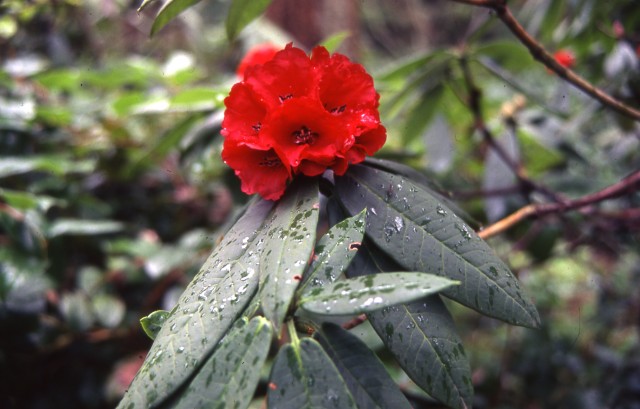
Rhododendron barbatum is another of the numerous fine species collected and introduced to western gardens by Joseph Hooker during his historical two-year expedition (1848-1850) into the Sikkim Himalaya. Although this species was first scientifically recorded by Wallich in 1829 and introduced on a small scale possibly around that time, J. D. Hooker is rightfully given credit for bringing this outstandingly ornamental plant into general cultivation. R. barbatum is one of the finest of the red-flowered species for all-around garden worthiness. With full rounded inflorescences of bright scarlet to crimson flowers in early spring, smooth and peeling reddish-brown bark, and attractive deep green foliage, this species has remained one of the most widely grown and sought after of all of Hooker’s introductions.
Rhododendron barbatum is native over much of the Himalayan Range, from Uttar Pradesh, India, in the west, through Nepal, Sikkim, and Bhutan, to western Arunachal Pradesh, India, in the east, with populations in adjacent areas of sourthern Tibet. This species is quite common in the wild, sometimes occurring as solid stands in forest openings, but more commonly seen as scattered individuals in coniferous and mixed forests. It is found from 8,000 to 12,000 feet (2,400 to 3,700m) in elevation and typically grows as a large upright shrub or small tree.
In cultivation, this species generally forms a large upright shrub or small tree up to 20 or 30 feet (around 9m) in height (after considerable time). The attractive and colorful bark ranks among the finest in the genus and is one of the outstanding ornamental attributes of this species. On older stems the smooth and shiny bark is peeling and reddish or purplish in color, providing beauty and color through the often rather dull winter season. The younger stems and leaf petioles are more or less covered with bristles or “barbs” which add to the overall ornamentation of the plant. The glabrous (smooth) deep green leaves are elliptic to somewhat lanceolate in shape with heavily impressed veins on the upper surface. This attractive foliage nicely offsets the tubular bell-shaped deep crimson to scarlet flowers in late winter or early spring. These are borne in a dense rounded inflorescence and are usually long-lasting if no heavy frosts occur. In a “good” spring without hard freezes here in the RSBG, plants of this species have been known to remain in flower for up to five weeks.
This species is a member of the small subsection Barbata which also includes the species erosum, exasperatum, succothii, and argipeplum. There has been a great deal of confusion over the correct name for the latter species which is still most often seen in collections as “R. smithii,” This species is very similar to R. barbatum, but is easily separated from it by the presence of a loose indumentum on the undersides of the leaves; otherwise, they are virtually interchangeable in the landscape. A taxon known as “R. imberbe” is often seen in cultivation and is virtually identical to R. barbatum, differing only in its lack of bristles on the branchlets and petioles. This plant is often considered to be a natural hybrid but is more likely just an unbarbed R. barbatum and has accordingly been lumped into that species. During an expedition to Sikkim in the spring of 1997, I was able to observe numerous populations of R. barbatum and R. argipeplum in their native habitats. In many of these populations I noted individuals matching the descriptions for RR. barbatum, argipeplum, and “imberbe” all growing side by side. In these same colonies one could also observe plants showing varying degrees of intermediate combinations of the features used to distinguish between the taxa mentioned above. Plants with varying degrees of indumentum and bristly petioles, plants with no indumentum or bristles, plants with indumentum but no bristles, etc., all clearly illustrating large variable populations. This is, of course, a limited perspective on the taxonomy of these two species which do occur as distinct, fairly uniform populations in many parts of their respective ranges. It is probably best to interpret the taxonomy of these taxa as correct for the time being, keeping in mind that intermediates do occur where the ranges of the two species overlap.
In the garden, R. barbatum is an easily cultivated, long-lived, and usually free-blooming species. Primarily a woodland species in the wild, it performs best in similar conditions under cultivation, preferring the light overhead cover of larger trees. This protects the plant from the hot afternoon sun and heavy winds as well as light frosts which can otherwise damage the early flowers. As always, a well-drained organic soil with adequate moisture through the growing season is best for good growth and health. Although rated as hardy from 0° to +5°F., this species is often considered to be too tender for even the maritime Pacific Northwest. This is simply not true if high altitude or selected hardy forms are cultivated. Numerous plants have attained heights of 10 to 15 feet here in the garden, surviving but suffering damage to the foliage and flower buds in a particularly bad year when it reached +4°F. The members of this subsection are said to be susceptible to powdery mildew, but we have seen little evidence of this on R. barbatum in our area.
This species won an Award of Merit when exhibited by Winterfold House, Surrey, in 1934. Probably due to its early bloom season, R. barbatum has been little used in hybridizing programs. There are several hybrids in the trade featuring this species as a parent however, including ‘Brightwell’ (x forrestii), ‘Appleford’ (x ‘Portia’), and the well-known ‘Nestor’ (x thomsonii).
ACCESSIONS IN THE COLLECTION OF THE RSF:
1965/304 Crarae (0R15). Long-lasting deep red flowers in early spring. One of our finest forms.
1970/018 Wood (0R15). Deeply impressed leaf veins create a bold foliage effect.
1970/049 Cecil Smith (0R15). A form with pure red flowers.
1975/253 Berry BG (0R15). Typically early and frost-resistant, the flowers of this selection are the deepest pure red and the most freely-produced of the several large specimens which are now a feature at Portland’s BerryBotanic Garden.
1977/583 USDA (0R15). No data recorded.
1978/043 Barto (0R15). Flowers red.
1991/091 Berg (0R15). From seed collected wild in the central Himalaya.
1991/051 BB#8807
1992/026 BB#8807
1994/088 BB#8807
1994/092 BB#8807 (0R15). All grown from seed collected wild by Warren Berg in the eastern Himalaya at 10,000 ft.
1991/057 BB#8808
1991/058 BB#8808
1992/029 BB#8808
1992/030 BB#8808
1992/081 BB#8808 (0R15). All grown from seed collected wild by Warren Berg at 11,420 ft. in the eastern Himalaya.
1994/009 BB#8806
1994/076 BB#8806 (0R15). All grown from seed collected wild by Warren Berg at 11,600 ft. in the eastern Himalaya.
1998/071
1998/150
1998/221 (0R15). All grown from seed collected wild in the eastern Himalaya at 10,500 ft.
2000/067 SEH#506
2000/081 SEH#506
2000/110 SEH#506 (0R15). All grown from seed collected at 10,700 ft. in the eastern Himalaya.
2001/160 SEH#546
2001/184 SEH#546
2001/201 SEH#546 (0R15). All grown from seed collected in the wild by Steve Hootman at 11,100 ft. in the eastern Himalaya.
2002/333 SEH#511
2002/368 SEH#511 (0R15). All grown from seed collected in the wild by Steve Hootman at 10,900 ft. in the eastern Himalaya.
2004/230 SEH#526
2004/265 SEH#526
2004/291 SEH#526 (0R15). All grown from seed collected in the wild by Steve Hootman at 9,850 ft. in the eastern Himalaya.
REFERENCES CONSULTED:
Chamberlain, D. F. 1982. “A Revision of Rhododendron. II. Subgenus Hymenanthes.” Notes from the Royal Botanic GardenEdinburgh. Vol. 39(2):pgs. 380-381.
Cox, Peter A., and Kenneth N. E. Cox. 1997. The Encyclopedia of Rhododendron Species. Perth, Scotland: Glendoick Publishing, 1997. Pgs. 25-26.
Davidian, H. H. 1989. The Rhododendron Species. Vol. II Timber Press. Portland , OR. pgs. 110 & 113.
Hootman, S. E. 1997. Unpublished field notes.
Rhododendron Species Foundation: Records – 1964 to present.
Steve Hootman
